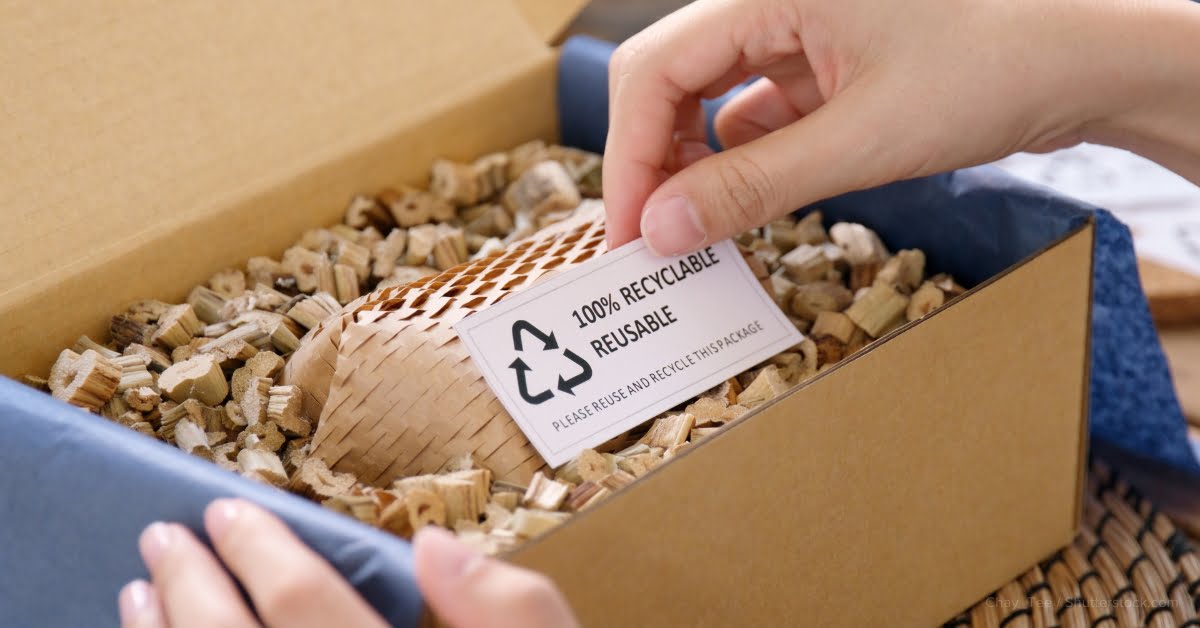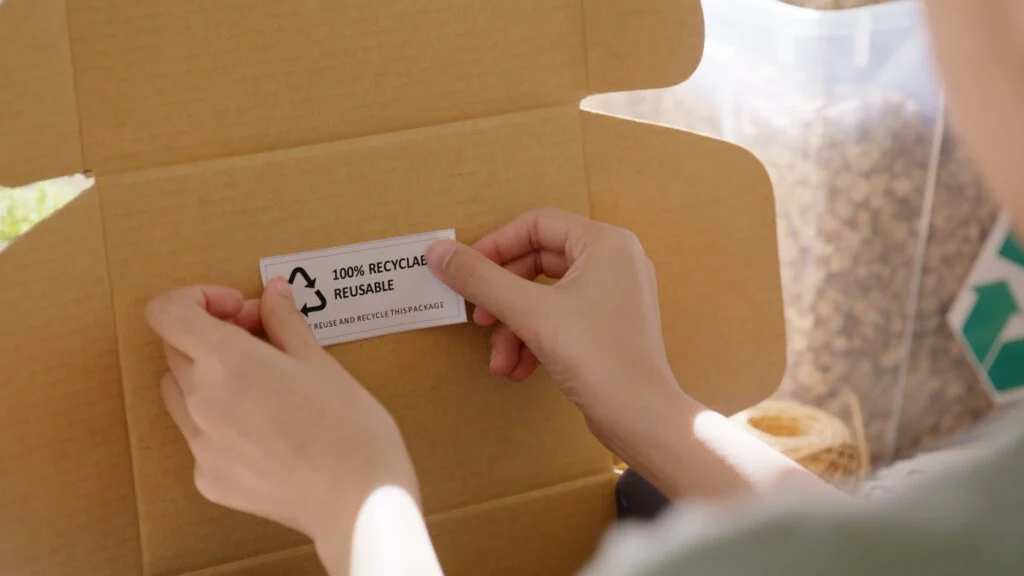Key takeaways
The emergence of e-commerce has transformed the way we purchase and receive goods, but it has also highlighted the urgent problem of unsustainable packing techniques. Conventional packing techniques, which mostly use non-biodegradable materials like cardboard and plastic, are exacerbating the environmental catastrophe. Businesses and consumers must consider the environmental effect of packaging and look for sustainable alternatives as more people purchase online. Eco-friendly packaging solutions, such reusable choices, minimalist package designs, and biodegradable materials, may help e-commerce enterprises draw in environmentally sensitive clients and improve their brand image while simultaneously lowering their environmental impact. It’s time for the online retail sector to put sustainability first and open the door for a greener future.

Introduction
The importance of packing in the dynamic world of online shopping cannot be understated. The increasing trend of online shopping is causing a boom in trash output and environmental impact due to the unsustainable nature of existing packing methods. There is, however, some optimism for a more environmentally responsible future in the e-commerce sector with the emergence of creative eco-friendly packaging options. Businesses may use sustainable packaging techniques to not only lessen their environmental impact but also draw in eco-aware customers and improve their reputation. It’s time for online retailers to put sustainability first and open the door to a greener customer experience.
The Rise of E-Commerce and Its Impact on Packaging
The growth of e-commerce has significantly changed the way that people purchase and receive goods, and this trend is expected to continue as long as the digital era lasts. Online shopping’s simplicity and convenience have driven up demand for packing materials to previously unheard-of levels. But this growth in demand has also resulted in a worrying side effect: a significant rise in waste produced by traditional packing techniques.
In light of this rising demand, the conventional packing techniques that have long been used in the e-commerce sector are showing to be unsustainable. Not only has the overuse of plastic, cardboard, and other non-biodegradable materials made waste management an even more urgent problem, but it has also caused long-term environmental damage.
E-commerce’s effects on packaging are significant. Excessive use of plastic, cardboard, and other non-biodegradable materials is common in traditional packaging. This has detrimental consequences on the environment in addition to adding to the expanding problem of trash management.
Businesses and consumers alike must address the environmental effect of packaging and find sustainable alternatives as more and more people purchase online.
Challenges of Traditional Packaging in E-Commerce
– Overuse of plastic: Since plastic is not biodegradable and takes hundreds of years to break down, it is frequently used extensively in traditional packaging. This adds to the amount of plastic debris that ends up in landfills and the ocean. The excessive use of plastic in e-commerce packaging endangers ecosystems and marine life in addition to adding to environmental degradation.
– Overuse of packing materials: E-commerce companies frequently utilize an excessive amount of packaging materials to safeguard their items during transportation, which increases trash production. The usage of needless packaging raises the transportation and shipping industry’s carbon footprint in addition to contributing to trash production overall.
– Inefficient use of space: Conventional packing techniques could not make the best use of available space, leading to packages that are bigger than necessary. This leads to higher transportation-related carbon emissions in addition to higher shipping expenses. E-commerce companies may improve sustainability standards and lessen their environmental effect by employing space-efficient packing options.
– Overuse of plastic: Since plastic is not biodegradable and takes hundreds of years to break down, it is frequently used extensively in traditional packaging. This adds to the amount of plastic debris that ends up in landfills and the ocean.
– Overuse of packing materials: E-commerce companies frequently utilize an excessive amount of packaging materials to safeguard their items during transportation, which increases trash production.
– Inefficient use of space: Conventional packing techniques could not make the best use of available space, leading to packages that are bigger than necessary. This leads to higher transportation-related carbon emissions in addition to higher shipping expenses.
These challenges highlight the need for sustainable packaging solutions in the e-commerce industry.
Benefits of Sustainable Packaging for E-Commerce Businesses
– Lessened influence on the environment: Eco-friendly, readily recyclable, or biodegradable materials are given priority in sustainable packaging techniques. E-commerce companies may help create a more environmentally friendly future by minimizing the quantity of non-biodegradable garbage they produce. This is essential for protecting the environment for coming generations as well as for reducing carbon emissions and conserving natural resources.
– Cost reductions: Using less material and improving package design are common components of sustainable packaging solutions, which can eventually result in cost savings. Businesses may save money on waste management and disposal expenses by decreasing packaging waste. Businesses may also be able to draw in environmentally concerned customers who are prepared to pay more for eco-friendly goods by investing in sustainable packaging techniques, which might increase sales. and revenue.
– Improved brand reputation: Customers are becoming more aware of how their purchases affect the environment. E-commerce companies may draw in eco-aware clients and build their brand equity by implementing sustainable packaging techniques. Businesses may stand out in a crowded market and win over customers’ trust and loyalty by developing a reputation as an ethical and ecologically conscientious brand. In the end, this can help e-commerce companies succeed and remain sustainable over the long run.
– Lessened influence on the environment: Eco-friendly, readily recyclable, or biodegradable materials are given priority in sustainable packaging techniques. E-commerce companies may help create a more environmentally friendly future by minimizing the quantity of non-biodegradable garbage they produce.
– Financial savings: Eco-friendly packaging solutions frequently minimize material use and maximize packaging design, which can result in financial savings in the long run. By reducing packaging waste, businesses can also save on waste management and disposal costs.
– Improved brand reputation: Customers are becoming more aware of how their purchases affect the environment. E-commerce companies may draw in eco-aware clients and build their brand equity by implementing sustainable packaging techniques.
These advantages present a strong argument in favor of e-commerce companies giving sustainable packaging a priority.
Innovative Eco-Friendly Packaging Solutions
In the e-commerce sector, creative environmentally friendly packaging alternatives have surfaced in reaction to the problems with conventional packaging. Several of these fixes consist of:
Biodegradable materials: Compared to conventional plastic packaging, packaging composed of biodegradable materials—such as plant-based fibers or compostable plastics—offers a more environmentally friendly option. The natural degradation of these materials over time lessens the negative environmental effects of packaging trash.
– Minimalist packaging: Using few materials and streamlining packaging design may save waste and maximize space usage. By emphasizing the product above ostentatious packaging, this method not only lessens its negative effects on the environment but also improves the unpacking experience for consumers.
– Reusable packaging: By offering reusable packaging solutions, including sturdy containers or refillable packaging, waste production may be greatly decreased and a circular economy can be fostered. Reusing packaging or returning it for refilling it can help businesses reduce their environmental impact and promote environmentally conscious consumer behavior.
These creative ideas open the door to a more sustainable and environmentally friendly future by showcasing the possibilities of eco-friendly packaging in the e-commerce sector.
Biodegradable materials: Compared to conventional plastic packaging, packaging composed of biodegradable materials—such as plant-based fibers or compostable plastics—offers a more environmentally friendly option.
– Minimalist packaging: Using few materials and streamlining packaging design may save waste and maximize space usage. This strategy not only lessens the impact on the environment but also improves the unpacking experience for clients.
– Reusable packaging: By offering reusable packaging solutions, including sturdy containers or refillable packaging, waste production may be greatly decreased and a circular economy can be fostered.
The e-commerce business may benefit greatly from eco-friendly packaging, as demonstrated by these creative ideas.
Implementing Sustainable Packaging Practices for a Greener Future
E-commerce companies must use sustainable packaging techniques if they want to embrace a greener future. Among the actions that companies can take are:
– Carrying out packaging audits: Businesses may better understand their environmental effect and establish sustainable packaging goals by evaluating their present packaging practices and pinpointing areas for improvement. This entails assessing the kinds of materials utilized, the volume of waste produced during the packing process, and the general effectiveness of the packaging procedures. Businesses may monitor their progress toward sustainability objectives and make wise decisions to lessen their environmental impact by regularly performing audits.
– Working closely with suppliers: Online retailers may find environmentally friendly packaging materials and investigate cutting-edge packaging options by collaborating closely with their suppliers. Businesses should make sure that their suppliers provide sustainable packaging solutions by giving them priority. supply chain is in line with their dedication to environmental stewardship. Working together with suppliers may also result in more affordable solutions and encourage a sustainable culture across the whole value chain.
– Educating staff members and clients: Changing e-commerce enterprises requires raising awareness of and comprehension of sustainable packaging methods. Employees can be empowered to take proactive measures towards sustainability by receiving education on the value of utilizing eco-friendly products, improving package design, and cutting waste. Furthermore, promoting sustainable consumer behavior and informing consumers about the advantages of eco-friendly packaging may improve the environment and instill a sense of shared responsibility.
E-commerce companies may make a big difference in lessening their environmental effect, encouraging sustainability, and contributing to a greener future for all.
– Carrying out packaging audits: Businesses may better understand their environmental effect and establish sustainable packaging goals by evaluating their present packaging practices and pinpointing areas for improvement.
– Selecting sustainable materials: You may drastically lessen your impact on the environment by using packaging materials that are recyclable, biodegradable, or derived from renewable resources.
– Properly sized packaging: Packaging may be designed to minimize waste and maximize transportation efficiency by fitting the product’s dimensions and minimizing vacant space.
– Education of consumers: By informing consumers about the value of sustainable packaging, you may increase awareness and persuade them to patronize companies that put an emphasis on environmentally friendly operations.
E-commerce companies may fulfill the demands of environmentally concerned customers and contribute to a greener future by implementing these actions.
Conclusions
In summary, it is clear that in order for the e-commerce sector to effectively tackle the environmental issues raised by conventional packaging techniques, sustainable packaging practices are essential. Businesses may drastically lower their carbon footprint, save money, and improve their reputation by emphasizing eco-friendly materials, improving package design, and encouraging recyclable solutions. Innovative environmentally friendly packaging options are starting to appear, which indicates that e-commerce has a bright future ahead of it. Through the adoption of sustainable packaging methods, frequent audits, supplier collaboration, employee and customer education, and other means, businesses may make a substantial contribution to the advancement of sustainability and a more environmentally friendly future for everybody. Prioritizing sustainable packaging is essential for e-commerce companies in order to satisfy the increasing consumer demand for eco-friendly goods and guarantee long-term profitability. in a competitive market.

FAQ
What is eco-friendly and sustainable packaging?
Packaging materials and procedures that emphasize the use of ecologically friendly materials and techniques throughout the packaging process are referred to as eco-friendly and sustainable packaging. This involves utilizing biodegradable materials to lessen the environmental effect of packaging waste. Examples of these materials are plant-based fibers and compostable polymers, which decompose naturally over time. In order to minimize waste and maximize space usage, sustainable packaging also incorporates reusable choices like sturdy containers or refillable packaging that support the circular economy. In order to fulfill the needs of environmentally conscious consumers and reduce their carbon footprint, firms should choose sustainable materials, size packaging appropriately, and educate customers about the value of eco-friendly operations. Adopting sustainable and eco-friendly packaging is crucial for companies trying to improve their brand reputation, reduce costs, and drive positive change in the e-commerce industry.
What are some sustainable and eco-friendly solutions for modern packaging?
Innovative materials, such as mushroom packaging, which uses mycelium to make biodegradable packaging that is both robust and sustainable, are some sustainable and environmentally friendly choices for modern packaging. Additionally, a biodegradable substitute for conventional plastics is provided by water-soluble packaging comprised of substances like starch or seaweed. Edible packaging is another environmentally beneficial option. It is made of materials that may be quickly degraded or safely ingested, such as rice paper or algae. These inventive methods of sustainable packaging not only lessen their negative effects on the environment, but they also demonstrate the e-commerce industry’s capacity for creative problem-solving. Businesses may further reduce their carbon footprint and contribute to a better future for everybody by adopting these contemporary packaging alternatives.
How can we make product packaging eco-friendly?
Businesses can investigate different sustainable procedures and materials to make product packaging more environmentally friendly. Using biodegradable materials, such plant-based fibers or compostable plastics, can help lessen the negative effects of packaging waste on the environment since they decompose naturally over time. Adopting minimalist packaging design is an additional choice; this strategy emphasizes simplicity and uses few materials to minimize waste and maximize space use. Reusable packaging alternatives, such as robust containers or refillable packaging, can also reduce waste production and advance the circular economy. Businesses have the power to drastically lower their carbon footprint and make a positive impact on the environment by emphasizing environmentally friendly materials, carefully considering package dimensions, and teaching consumers about the advantages of sustainable practices. Adopting these environmentally friendly packaging options is crucial for companies wishing to to enhance their brand reputation, save costs, and drive positive change in the e-commerce industry.
Why is it important to have environmentally friendly packaging?
It’s important to choose eco-friendly packaging for a number of reasons. First of all, it lessens the harm that conventional packing techniques cause to the environment. Utilizing reusable choices, simple designs, and biodegradable materials, organizations may drastically reduce trash production and encourage packaging that is more environmentally friendly.
Second, eco-friendly packaging may have a positive financial impact on companies. Over time, firms can achieve cost savings through the implementation of new solutions, optimal space utilization, and material reduction. Prioritizing ecologically friendly packaging may also improve a brand’s reputation and draw in customers who are looking for eco-friendly items.
Furthermore, satisfying the market’s increasing demand for sustainable products requires the use of ecologically appropriate packaging. As traditional packaging contributes to environmental problems, consumers are actively looking for items that reflect their beliefs. Businesses may meet this need and set themselves apart in a crowded market by providing eco-friendly packaging solutions.
All things considered, adopting ecologically friendly packaging is crucial for businesses to stay current and satisfy modern consumers, as well as for the environment and financial health of the company. E-commerce companies may promote good change in the industry and contribute to a greener future by making sustainability a priority in their packaging practices.
Hope this article was helpful for more check out our previous blog post by clicking here .

